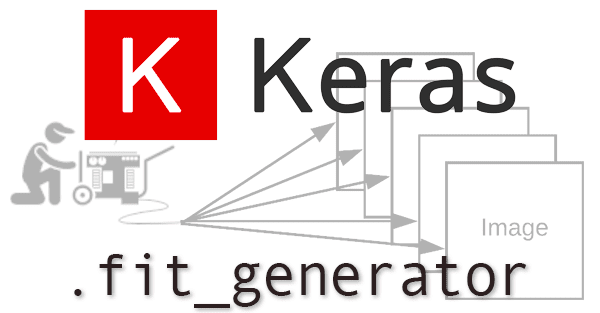
In this tutorial, you will learn how the Keras .fit and .fit_generator functions work, including the differences between them. To help you gain hands-on experience, I’ve included a full example showing you how to implement a Keras data generator from scratch.
Today’s blog post is inspired by PyImageSearch reader, Shey.
Shey asks:
Hi Adrian, thanks for your tutorials. I’ve been methodically going through every one. They’ve really helped me learn deep learning. I have a question about the Keras “.fit_generator” function. I’ve noticed you use it quite a bit in your blog posts but I’m not really sure how the function is different than Keras’ standard “.fit” function. How is it different? How do I know when to use each? And how to I create a data generator for the “.fit_generator” function?
Shey asks a great question.
The Keras deep learning library includes three separate functions that can be used to train your own models:
.fit
.fit_generator
.train_on_batch
If you’re new to Keras and deep learning you may feel a bit overwhelmed trying to determine which function you’re supposed to use — this confusion is only compounded if you need to work with your own custom data.
To help lift the cloud of confusion regarding the Keras fit and fit_generator functions, I’m going to spend this tutorial discussing:
The differences between Keras’ .fit , .fit_generator , and .train_on_batch functions
- When to use each when training your own deep learning models
How to implement your own Keras data generator and utilize it when training a model using .fit_generator How to use the .predict_generator function when evaluating your network after training
To learn more about Keras’ .fit and .fit_generator functions, including how to train a deep learning model on your own custom dataset, just keep reading!
How to use Keras fit and fit_generator (a hands-on tutorial)
In the first part of today’s tutorial we’ll discuss the differences between Keras’ .fit , .fit_generator , and .train_on_batch functions.
From there I’ll show you an example of a “non-standard” image dataset which doesn’t contain any actual PNG, JPEG, etc. images at all! Instead, the entire image dataset is represented by two CSV files, one for training and the second for evaluation.
Our goal will be to implement a Keras generator capable of training a network on this CSV image data (don’t worry, I’ll show you how to implement such a generator function from scratch).
Finally, we’ll train and evaluate our network.
When to use Keras’ fit, fit_generator, and train_on_batch functions?
Keras provides three functions that can be used to train your own deep learning models:
.fit
.fit_generator
.train_on_batch
All three of these functions can essentially accomplish the same task — but how they go about doing it is very different.
Let’s explore each of these functions one-by-one, looking at an example function call, and then discussing how they are different from each other.
The Keras .fit function
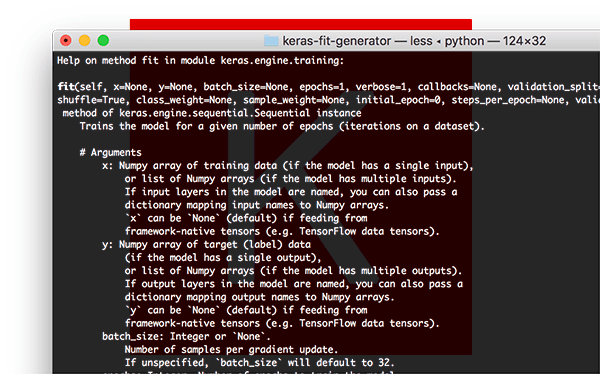
Figure 1: The Keras .fit function signature.
Let’s start with a call to .fit :
| model.fit(trainX, trainY, batch_size=32, epochs=50) |
Here you can see that we are supplying our training data ( trainX ) and training labels ( trainY ).
We then instruct Keras to allow our model to train for 50 epochs with a batch size of 32 .
The call to .fit is making two primary assumptions here:
-
Our entire training set can fit into RAM
-
There is no data augmentation going on (i.e., there is no need for Keras generators)
Instead, our network will be trained on the raw data.
The raw data itself will fit into memory — we have no need to move old batches of data out of RAM and move new batches of data into RAM.
Furthermore, we will not be manipulating the training data on the fly using data augmentation.
The Keras fit_generator function
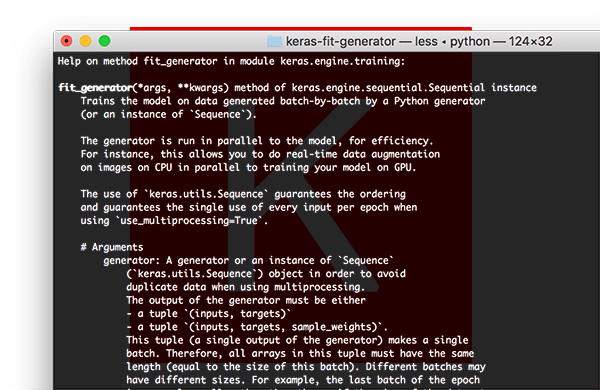
Figure 2: The Keras .fit_generator function allows for data augmentation and data generators.
For small, simplistic datasets it’s perfectly acceptable to use Keras’ .fit function.
These datasets are often not very challenging and do not require any data augmentation.
However, real-world datasets are rarely that simple:
-
Real-world datasets are often too large to fit into memory.
-
They also tend to be challenging, requiring us to perform data augmentation to avoid overfitting and increase the ability of our model to generalize.
In those situations we need to utilize Keras’ .fit_generator function:
| # initialize the number of epochs and batch sizeEPOCHS = 100BS = 32 # construct the training image generator for data augmentationaug = ImageDataGenerator(rotation_range=20, zoom_range=0.15, width_shift_range=0.2, height_shift_range=0.2, shear_range=0.15, horizontal_flip=True, fill_mode=”nearest”) # train the networkH = model.fit_generator(aug.flow(trainX, trainY, batch_size=BS), validation_data=(testX, testY), steps_per_epoch=len(trainX) // BS, epochs=EPOCHS) |
EPOCHS = 100
aug = ImageDataGenerator(rotation_range=20, zoom_range=0.15,
horizontal_flip=True, fill_mode=”nearest”)
train the network
validation_data=(testX, testY), steps_per_epoch=len(trainX) // BS,
Here we start by first initializing the number of epochs we are going to train our network for along with the batch size.
We then initialize aug , a Keras ImageDataGenerator object that is used to apply data augmentation, randomly translating, rotating, resizing, etc. images on the fly.
Performing data augmentation is a form of regularization, enabling our model to generalize better.
However, applying data augmentation implies that our training data is no longer “static” — the data is constantly changing.
Each new batch of data is randomly adjusted according to the parameters supplied to ImageDataGenerator .
Thus, we now need to utilize Keras’ .fit_generator function to train our model.
As the name suggests, the .fit_generator function assumes there is an underlying function that is generating the data for it.
The function itself is a Python generator.
Internally, Keras is using the following process when training a model with .fit_generator :
Keras calls the generator function supplied to .fit_generator (in this case, aug.flow ). The generator function yields a batch of size BS to the .fit_generator function. The .fit_generator function accepts the batch of data, performs backpropagation, and updates the weights in our model.
- This process is repeated until we have reached the desired number of epochs.
You’ll notice we now need to supply a steps_per_epoch parameter when calling .fit_generator (the .fit method had no such parameter).
Why do we need steps_per_epoch ?
Keep in mind that a Keras data generator is meant to loop infinitely — it should never return or exit.
Since the function is intended to loop infinitely, Keras has no ability to determine when one epoch starts and a new epoch begins.
Therefore, we compute the steps_per_epoch value as the total number of training data points divided by the batch size. Once Keras hits this step count it knows that it’s a new epoch.
The Keras train_on_batch function
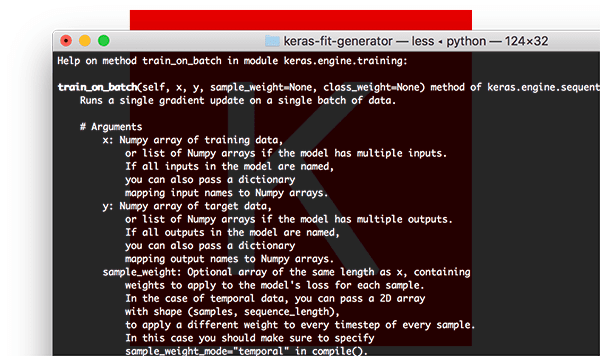
Figure 3: The .train_on_batch function in Keras offers expert-level control over training Keras models.
For deep learning practitioners looking for the finest-grained control over training your Keras models, you may wish to use the .train_on_batch function:
| model.train_on_batch(batchX, batchY) |
The train_on_batch function accepts a single batch of data, performs backpropagation, and then updates the model parameters.
The batch of data can be of arbitrary size (i.e., it does not require an explicit batch size to be provided).
The data itself can be generated however you like as well. This data could be raw images on disk or data that has been modified or augmented in some manner.
You’ll typically use the .train_on_batch function when you have very explicit reasons for wanting to maintain your own training data iterator, such as the data iteration process being extremely complex and requiring custom code.
If you find yourself asking if you need the .train_on_batch function then in all likelihood you probably don’t.
In 99% of the situations you will not need such fine-grained control over training your deep learning models. Instead, a custom Keras .fit_generator function is likely all you need it.
That said, it’s good to know that the function exists if you ever need it.
I typically only recommend using the .train_on_batch function if you are an advanced deep learning practitioner/engineer, and you know exactly what you’re doing and why.
An image dataset…as a CSV file?
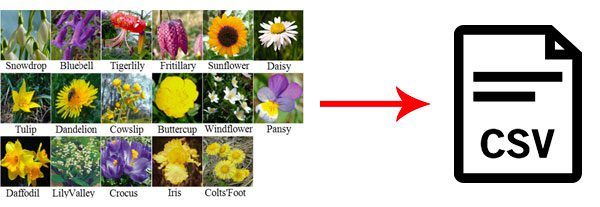
Figure 4: The Flowers-17 dataset has been serialized into two CSV files (training and evaluation). In this blog post we’ll write a custom Keras generator to parse the CSV data and yield batches of images to the .fit_generator function. (credits: image & icon)
The dataset we will be using here today is the Flowers-17 dataset, a collection of 17 different flower species with 80 images per class.
Our goal will be to train a Keras Convolutional Neural Network to correctly classify each species of flowers.
However, there’s a bit of a twist to this project:
-
Instead of working with the raw image files residing on disk…
-
…I’ve serialized the entire image dataset to two CSV files (one for training, and one for evaluation).
To construct each CSV file I:
-
Looped over all images in our input dataset
-
Resized them to 64×64 pixels
-
Flattened the 64x64x3=12,288 RGB pixel intensities into a single list
-
Wrote 12,288 pixel values + class label to the CSV file (one per line)
Our goal is to now write a custom Keras generator to parse the CSV file and yield batches of images and labels to the .fit_generator function.
Wait, why bother with a CSV file if you already have the images?
Today’s tutorial is meant to be an example of how to implement your own Keras generator for the .fit_generator function.
In the real-world datasets are not nicely curated for you:
-
You may have unstructured directories of images.
-
You could be working with both images and text.
-
Your images could be serialized in a particular format, whether that’s a CSV file, a Caffe or TensorFlow record file, etc.
In these situations, you will need to know how to write your own Keras generator functions.
Keep in mind that it’s not the particular data format that’s important here — it’s the actual process of writing your own Keras generator that you need to learn (and that’s exactly what’s covered in the rest of the tutorial).
Project structure
Let’s inspect the project tree for today’s example:
| $ tree –dirsfirst.├── pyimagesearch│ ├── init.py│ └── minivggnet.py├── flowers17_testing.csv├── flowers17_training.csv├── plot.png└── train.py 1 directory, 6 files |
.
│ ├── init.py
├── flowers17_testing.csv
├── plot.png
Today we’ll be using the MiniVGGNet CNN. We won’t be covering the implementation here today as I’ll assume you already know how to implement a CNN. If not, no worries — just refer to my Keras tutorial.
Our serialized image dataset is contained within flowers17_training.csv and flowers17_testing.csv (included in the “Downloads” associated with today’s post).
We’ll be reviewing train.py , our training script, in the next two sections.
Implementing a custom Keras fit_generator function
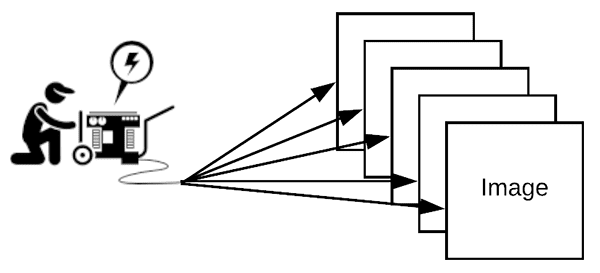
Figure 5: What’s our fuel source for our ImageDataGenerator? Two CSV files with serialized image text strings. The generator engine is the ImageDataGenerator from Keras coupled with our custom csv_image_generator. The generator will burn the CSV fuel to create batches of images for training.
Let’s go ahead and get started.
I’ll be assuming you have the following libraries installed on your system:
-
NumPy
-
TensorFlow + Keras
-
Scikit-learn
-
Matplotlib
Each of these packages can be installed via pip in your virtual environment. If you have virtualenvwrapper installed you can create an environment with mkvirtualenv and activate your environment with the workon command. From there you can use pip to set up your environment:
| $ mkvirtualenv cv -p python3$ workon cv$ pip install numpy$ pip install tensorflow # or tensorflow-gpu$ pip install keras$ pip install scikit-learn$ pip install matplotlib |
$ workon cv
$ pip install tensorflow # or tensorflow-gpu
$ pip install scikit-learn
Once your virtual environment is set up, you can proceed with writing the training script. Make sure you use the “Downloads” section of today’s post grab the source code and Flowers-17 CSV image dataset.
Open up the train.py file and insert the following code:
| # set the matplotlib backend so figures can be saved in the backgroundimport matplotlibmatplotlib.use(“Agg”) # import the necessary packagesfrom keras.preprocessing.image import ImageDataGeneratorfrom keras.optimizers import SGDfrom sklearn.preprocessing import LabelBinarizerfrom sklearn.metrics import classification_reportfrom pyimagesearch.minivggnet import MiniVGGNetimport matplotlib.pyplot as pltimport numpy as np |
import matplotlib
from keras.preprocessing.image import ImageDataGenerator
from sklearn.preprocessing import LabelBinarizer
from pyimagesearch.minivggnet import MiniVGGNet
import numpy as np
Lines 2-12 import our required packages and modules. Since we’ll be saving our training plot to disk, Line 3 sets matplotlib ‘s backend appropriately.
Notable imports include ImageDataGenerator , which contains the data augmentation and image generator functionality, along with MiniVGGNet , our CNN that we will be training.
Let’s define the csv_image_generator function:
| def csv_image_generator(inputPath, bs, lb, mode=”train”, aug=None): # open the CSV file for reading f = open(inputPath, “r”) |
# open the CSV file for reading
On Line 14 we’ve defined the csv_image_generator . This function is responsible for reading our CSV data file and loading images into memory. It yields batches of data to our Keras .fit_generator function.
As such, the function accepts the following parameters:
inputPath : the path to the CSV dataset file.
bs : The batch size. We’ll be using 32.
lb : A label binarizer object which contains our class labels.
mode : (default is “train” ) If and only if the mode==”eval” , then a special accommodation is made to not apply data augmentation via the aug object (if one is supplied).
aug : (default is None ) If an augmentation object is specified, then we’ll apply it before we yield our images and labels.
On Line 16 we’ll go ahead and open the CSV data file for reading.
Let’s begin looping over the lines of data:
| # loop indefinitely while True: # initialize our batches of images and labels images = [] labels = [] |
while True:
images = []
Each line of data in the CSV file contains an image serialized as a text string. Again, I generated the text strings from the Flowers-17 dataset. Additionally, I know this isn’t the most efficient way to store an image, but it is great for the purposes of this example.
Our Keras generator must loop indefinitely as is defined on Line 19. The .fit_generator function will be calling our csv_image_generator function each time it needs a new batch of data.
And furthermore, Keras maintains a cache/queue of data, ensuring the model we are training always has data to train on. Keras constantly keeps this queue full so even if you have reached the total number of epochs to train for, keep in mind that Keras is still feeding the data generator, keeping data in the queue.
Always make sure your function returns data, otherwise, Keras will error out saying it could not obtain more training data from your generator.
At each iteration of the loop, we’ll reinitialize our images and labels to empty lists (Lines 21 and 22).
From there, we’ll begin appending images and labels to these lists until we’ve reached our batch size:
| 24252627282930313233343536373839404142434445464748495051 | # keep looping until we reach our batch size while len(images) < bs: # attempt to read the next line of the CSV file line = f.readline() # check to see if the line is empty, indicating we have # reached the end of the file if line == “”: # reset the file pointer to the beginning of the file # and re-read the line f.seek(0) line = f.readline() # if we are evaluating we should now break from our # loop to ensure we don’t continue to fill up the # batch from samples at the beginning of the file if mode == “eval”: break # extract the label and construct the image line = line.strip().split(“,”) label = line[0] image = np.array([int(x) for x in line[1:]], dtype=”uint8”) image = image.reshape((64, 64, 3)) # update our corresponding batches lists images.append(image) labels.append(label) |
25
27
29
31
33
35
37
39
41
43
45
47
49
51
while len(images) < bs:
line = f.readline()
# check to see if the line is empty, indicating we have
if line == “”:
# and re-read the line
line = f.readline()
# if we are evaluating we should now break from our
# batch from samples at the beginning of the file
break
# extract the label and construct the image
label = line[0]
image = image.reshape((64, 64, 3))
# update our corresponding batches lists
labels.append(label)
Let’s walk through this loop:
First, we read a line from our text file object, f (Line 27). If line is empty:
…we reset our file pointer and try to read a line (Lines 34 and 35). And if we’re in evaluation mode , we go ahead and break from the loop (Lines 40 and 41).
Note:The key to making evaluation work here is that we supply the number of steps to model.predict_generator , ensuring that each image in the testing set is predicted only once. I’ll be covering how to do this process later in the tutorial.
With our batch of images and corresponding labels ready, we can now take two steps before yielding our batch:
| # one-hot encode the labels labels = lb.transform(np.array(labels)) # if the data augmentation object is not None, apply it if aug is not None: (images, labels) = next(aug.flow(np.array(images), labels, batch_size=bs)) # yield the batch to the calling function yield (np.array(images), labels) |
labels = lb.transform(np.array(labels))
# if the data augmentation object is not None, apply it
(images, labels) = next(aug.flow(np.array(images),
yield (np.array(images), labels)
Our final steps include:
One-hot encoding labels (Line 54)
- Applying data augmentation if necessary (Lines 57-59)
Finally, our generator “yields” our array of images and our list of labels to the calling function on request (Line 62). If you aren’t familiar with the yield keyword, it is used for Python Generator functions as a convenient shortcut in place of building an iterator class with less memory consumption. You can read more about Python Generators here.
Let’s initialize our training parameters:
| # initialize the paths to our training and testing CSV filesTRAIN_CSV = “flowers17_training.csv”TEST_CSV = “flowers17_testing.csv” # initialize the number of epochs to train for and batch sizeNUM_EPOCHS = 75BS = 32 # initialize the total number of training and testing imageNUM_TRAIN_IMAGES = 0NUM_TEST_IMAGES = 0 |
TRAIN_CSV = “flowers17_training.csv”
NUM_EPOCHS = 75
NUM_TRAIN_IMAGES = 0
A number of initializations are hardcoded in this example training script:
-
Our training and testing CSV filepaths (Lines 65 and 66).
-
The number of epochs and batch size for training (Lines 69 and 70).
-
Two variables which will hold the number of training and testing images (Lines 73 and 74).
Let’s take a look at the next block of code:
| 767778798081828384858687888990919293949596979899100101102103 | # open the training CSV file, then initialize the unique set of class# labels in the dataset along with the testing labelsf = open(TRAIN_CSV, “r”)labels = set()testLabels = [] # loop over all rows of the CSV filefor line in f: # extract the class label, update the labels list, and increment # the total number of training images label = line.strip().split(“,”)[0] labels.add(label) NUM_TRAIN_IMAGES += 1 # close the training CSV file and open the testing CSV filef.close()f = open(TEST_CSV, “r”) # loop over the lines in the testing filefor line in f: # extract the class label, update the test labels list, and # increment the total number of testing images label = line.strip().split(“,”)[0] testLabels.append(label) NUM_TEST_IMAGES += 1 # close the testing CSV filef.close() |
77
79
81
83
85
87
89
91
93
95
97
99
101
103
labels in the dataset along with the testing labels
labels = set()
for line in f:
# the total number of training images
labels.add(label)
f.close()
for line in f:
# increment the total number of testing images
testLabels.append(label)
f.close()
This block of code is long, but it has three purposes:
Extract all labels from our training dataset so that we can subsequently determine unique labels. Notice that labels is a set which only allows unique entries. Assemble a list of testLabels . Count the NUM_TRAIN_IMAGES and NUM_TEST_IMAGES .
Let’s build our LabelBinarizer object and construct the data augmentation object:
| 105106107108109110111112113114 | # create the label binarizer for one-hot encoding labels, then encode# the testing labelslb = LabelBinarizer()lb.fit(list(labels))testLabels = lb.transform(testLabels) # construct the training image generator for data augmentationaug = ImageDataGenerator(rotation_range=20, zoom_range=0.15, width_shift_range=0.2, height_shift_range=0.2, shear_range=0.15, horizontal_flip=True, fill_mode=”nearest”) |
106
108
110
112
114
the testing labels
lb.fit(list(labels))
aug = ImageDataGenerator(rotation_range=20, zoom_range=0.15,
horizontal_flip=True, fill_mode=”nearest”)
Using the unique labels, we’ll .fit our LabelBinarizer object (Lines 107 and 108).
We’ll also go ahead and transform our testLabels into binary one-hot encoded testLabels (Line 109).
From there, we’ll construct aug , an ImageDataGenerator (Lines 112-114). Our image data augmentation object will randomly rotate, flip, shear, etc. our training images.
Now let’s initialize our training and testing image generators:
| # initialize both the training and testing image generatorstrainGen = csv_image_generator(TRAIN_CSV, BS, lb, mode=”train”, aug=aug)testGen = csv_image_generator(TEST_CSV, BS, lb, mode=”train”, aug=None) |
trainGen = csv_image_generator(TRAIN_CSV, BS, lb,
testGen = csv_image_generator(TEST_CSV, BS, lb,
Our trainGen and testGen generator objects generate image data from their respective CSV files using the csv_image_generator (Lines 117-120).
Notice the subtle similarities and differences:
We’re using mode=”train” for both generators Only trainGen will perform data augmentation
Let’s initialize + compile our MiniVGGNet model with Keras and begin training:
| 122123124125126127128129130131132133134135 | # initialize our Keras model and compile itmodel = MiniVGGNet.build(64, 64, 3, len(lb.classes_))opt = SGD(lr=1e-2, momentum=0.9, decay=1e-2 / NUM_EPOCHS)model.compile(loss=”categorical_crossentropy”, optimizer=opt, metrics=[“accuracy”]) # train the networkprint(“[INFO] training w/ generator…“)H = model.fit_generator( trainGen, steps_per_epoch=NUM_TRAIN_IMAGES // BS, validation_data=testGen, validation_steps=NUM_TEST_IMAGES // BS, epochs=NUM_EPOCHS) |
123
125
127
129
131
133
135
model = MiniVGGNet.build(64, 64, 3, len(lb.classes_))
model.compile(loss=”categorical_crossentropy”, optimizer=opt,
print(“[INFO] training w/ generator…”)
trainGen,
validation_data=testGen,
epochs=NUM_EPOCHS)
Lines 123-126 compile our model. We’re using a Stochastic Gradient Descent optimizer with a hardcoded initial learning rate of 1e-2 . Learning rate decay is applied at each epoch. Categorical crossentropy is used since we have more than 2 classes (binary crossentropy would be used otherwise). Be sure to refer to my Keras tutorial for additional reading.
On Lines 130-135we call .fit_generator to start training.
The trainGen generator object is responsible for yielding batches of data and labels to the .fit_generator function.
Notice how we compute the steps per epoch and validation steps based on number of images and batch size. It’s paramount that we supply the steps_per_epoch value, otherwise Keras will not know when one epoch starts and another one begins.
Now let’s evaluate the results of training:
| 137138139140141142143144145146147148149150 | # re-initialize our testing data generator, this time for evaluatingtestGen = csv_image_generator(TEST_CSV, BS, lb, mode=”eval”, aug=None) # make predictions on the testing images, finding the index of the# label with the corresponding largest predicted probabilitypredIdxs = model.predict_generator(testGen, steps=(NUM_TEST_IMAGES // BS) + 1)predIdxs = np.argmax(predIdxs, axis=1) # show a nicely formatted classification reportprint(“[INFO] evaluating network…“)print(classification_report(testLabels.argmax(axis=1), predIdxs, target_names=lb.classes_)) |
138
140
142
144
146
148
150
testGen = csv_image_generator(TEST_CSV, BS, lb,
label with the corresponding largest predicted probability
steps=(NUM_TEST_IMAGES // BS) + 1)
print(“[INFO] evaluating network…”)
target_names=lb.classes_))
We go ahead and re-initialize our testGen , this time changing the mode to “eval” for evaluation purposes.
After re-initialization, we make predictions using our .predict_generator function and our testGen (Lines 143 and 144). At the end of this process, we’ll proceed to grab the max prediction indices (Line 145).
Using the testLabels and predIdxs , we’ll generate a classification_report via scikit-learn (Lines 149 and 150). The classification report is printed nicely to our terminal for inspection at the end of training and evaluation.
As a final step, we’ll use our training history dictionary, H , to generate a plot with matplotlib:
| 152153154155156157158159160161162163164 | # plot the training loss and accuracyN = NUM_EPOCHSplt.style.use(“ggplot”)plt.figure()plt.plot(np.arange(0, N), H.history[“loss”], label=”train_loss”)plt.plot(np.arange(0, N), H.history[“val_loss”], label=”val_loss”)plt.plot(np.arange(0, N), H.history[“acc”], label=”train_acc”)plt.plot(np.arange(0, N), H.history[“val_acc”], label=”val_acc”)plt.title(“Training Loss and Accuracy on Dataset”)plt.xlabel(“Epoch #”)plt.ylabel(“Loss/Accuracy”)plt.legend(loc=”lower left”)plt.savefig(“plot.png”) |
153
155
157
159
161
163
N = NUM_EPOCHS
plt.figure()
plt.plot(np.arange(0, N), H.history[“val_loss”], label=”val_loss”)
plt.plot(np.arange(0, N), H.history[“val_acc”], label=”val_acc”)
plt.xlabel(“Epoch #”)
plt.legend(loc=”lower left”)
The accuracy/loss plot is generated and saved to disk as plot.png for inspection upon script exit.
Training a Keras model using fit_generator and evaluating with predict_generator
To train our Keras model using our custom data generator, make sure you use the “Downloads” section to download the source code and example CSV image dataset.
From there, open a terminal, navigate to where you downloaded the source code + dataset, and execute the following command:
| 1234567891011121314151617181920212223242526272829303132333435363738 | $ python train.pyUsing TensorFlow backend.[INFO] training w/ generator…Epoch 1/7531/31 [==============================] - 5s - loss: 3.5171 - acc: 0.1381 - val_loss: 14.5745 - val_acc: 0.0906Epoch 2/7531/31 [==============================] - 4s - loss: 3.0275 - acc: 0.2258 - val_loss: 14.1294 - val_acc: 0.1187Epoch 3/7531/31 [==============================] - 4s - loss: 2.6691 - acc: 0.2823 - val_loss: 14.4892 - val_acc: 0.0781…Epoch 73/7531/31 [==============================] - 4s - loss: 0.3604 - acc: 0.8720 - val_loss: 0.7640 - val_acc: 0.7656Epoch 74/7531/31 [==============================] - 4s - loss: 0.3185 - acc: 0.8851 - val_loss: 0.7459 - val_acc: 0.7812Epoch 75/7531/31 [==============================] - 4s - loss: 0.3346 - acc: 0.8821 - val_loss: 0.8337 - val_acc: 0.7719[INFO] evaluating network… precision recall f1-score support bluebell 0.95 0.86 0.90 21 buttercup 0.50 0.93 0.65 15 coltsfoot 0.71 0.71 0.71 21 cowslip 0.71 0.75 0.73 20 crocus 0.78 0.58 0.67 24 daffodil 0.81 0.63 0.71 27 daisy 0.93 0.78 0.85 18 dandelion 0.71 0.94 0.81 18 fritillary 0.90 0.86 0.88 22 iris 1.00 0.79 0.88 24 lilyvalley 0.80 0.73 0.76 22 pansy 0.83 0.83 0.83 18 snowdrop 0.71 0.68 0.70 22 sunflower 1.00 0.94 0.97 18 tigerlily 1.00 0.93 0.96 14 tulip 0.50 0.31 0.38 16 windflower 0.59 1.00 0.74 20 avg / total 0.80 0.77 0.77 340 |
2
4
6
8
10
12
14
16
18
20
22
24
26
28
30
32
34
36
38
Using TensorFlow backend.
Epoch 1/75
Epoch 2/75
Epoch 3/75
…
31/31 [==============================] - 4s - loss: 0.3604 - acc: 0.8720 - val_loss: 0.7640 - val_acc: 0.7656
31/31 [==============================] - 4s - loss: 0.3185 - acc: 0.8851 - val_loss: 0.7459 - val_acc: 0.7812
31/31 [==============================] - 4s - loss: 0.3346 - acc: 0.8821 - val_loss: 0.8337 - val_acc: 0.7719
precision recall f1-score support
bluebell 0.95 0.86 0.90 21
coltsfoot 0.71 0.71 0.71 21
crocus 0.78 0.58 0.67 24
daisy 0.93 0.78 0.85 18
fritillary 0.90 0.86 0.88 22
lilyvalley 0.80 0.73 0.76 22
snowdrop 0.71 0.68 0.70 22
tigerlily 1.00 0.93 0.96 14
windflower 0.59 1.00 0.74 20
avg / total 0.80 0.77 0.77 340
 Figure 6: Our accuracy/loss Keras training plot for MiniVGGNet trained on Flowers-17.
Figure 6: Our accuracy/loss Keras training plot for MiniVGGNet trained on Flowers-17.
Here you can see that our network has obtained 80% accuracy on the evaluation set, which is quite respectable for the relatively shallow CNN used.
Most importantly, you learned how to utilize:
- Data generators
.fit_generator
.predict_generator
…all to train and evaluate your own custom Keras model!
Again, it’s not the actual format of the data itself that’s important here. Instead of CSV files, we could have been working with Caffe or TensorFlow record files, a combination of numerical/categorical data along with images, or any other synthesis of data that you may encounter in the real-world.
Instead, it’s the actual process of implementing your own Keras data generator that matters here.
Follow the steps in this tutorial and you’ll have a blueprint that you can use for implementing your own Keras data generators.
Need more hands-on experience working with large datasets and Keras generators?
Are you interested in gaining more hands-on experience working with large datasets and deep learning?
If so, you’ll want to take a look at my book, Deep Learning for Computer Vision with Python.
Inside the book you’ll find:
-
Super practical walkthroughs that present solutions to actual, real-world image classification problems on large datasets.
-
Hands-on tutorials (with lots of code) that not only show you the algorithms behind deep learning for computer vision but their implementations as well, including how to work with large amounts of data and train Keras deep learning models on top of your dataset.
-
A no-nonsense teaching style that is guaranteed help you master deep learning for image understanding and visual recognition.
To learn more about my deep learning book (and grab your free PDF of sample chapters and table of contents), just click here.
Summary
In this tutorial you learned the differences between Keras’ three primary functions used to train a deep neural network:
.fit : Used when the entire training dataset can fit into memory and no data augmentation is applied.
.fit_generator : Should be used when either (1) the dataset is too large to fit into memory, (2) data augmentation needs to be applied, or (3) in any situation when it’s more convenient to yield training data in batches (i.e., using the flow_from_directory function).
.train_on_batch : Can be used to train a Keras model on a single batch of data. Should be utilized only when you need the finest-grained control training your network, such as in situations where your data iterator is highly complex.
From there, we discovered how to:
- Implement our own custom Keras generator function
Use our custom generator along with Keras’ .fit_generator to train our deep neural network
You can use today’s example code as a template when implementing your own Keras generators in your own projects.
I hope you enjoyed today’s blog post!
To download the source code to this post, and be notified when future tutorials are published here on PyImageSearch, just enter your email address in the form below!